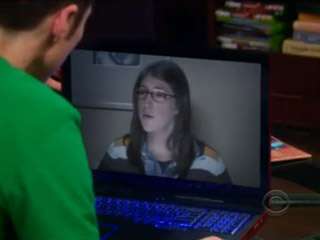Hollywood Web Cam
Webcams and Video Phones are amazing communication tools. More than just hearing a familiar voice, you can see the face of the person you're talking to, see the sparkle in their eyes, view their reaction to your Incredibly Lame Pun. It's almost like being in the same room with the person on the other end.
In Hollywood, a webcam really is like being in the same room with the other person.
To be fair, most such depictions of the Hollywood Web Cam are easily justified. For example, webcams are commercially available which boast 1080p resolution, justifying the high-res webcam shots usually shown on film. Further, even though in real life many people still have to contend with some noticable lag when using the Internet, this is removed from fiction because the gaps in conversation would be distracting, even annoying.
More difficult to explain away is the common occurrence that the person on the other end of the webcam call will turn her head back and forth when talking to two or more people on this end, as if glancing back and forth between them. In reality, unless she is watching a wall-sized monitor which displays a wide-angle shot of the location she's calling to, this means she's on the other end, turning her head back and forth looking at absolutely nothing.
In a similar vein, if the (non-diagetic) camera is filming the computer from an off angle such as a 3/4 shot, the face on the computer screen will be turned to match that angle (see page image). In reality, this again means that the person on the other end is now looking off to the side, at absolutely nothing. Try walking a large semi-circle around your television during a news broadcast and see if the face on the screen rotates appropriately.
Again, though, this is not necessarily a bad thing. The whole "three-dimensional face on a flat screen" thing is probably an attempt to avoid a trip into the Uncanny Valley. After all, when you walked that semi-circle around your TV (admit it, you did), didn't it look creepy to have that face always looking directly at you? The reason the face doesn't change with the angle is because, of course, it's a flat image; but, although we know intellectually that this is correct, emotionally it just rubs the wrong way. The Hollywood Web Cam solves this by giving us a 3D face on the screen; it's an Acceptable Break From Reality. And this doesn't even take into account any Applied Phlebotinum which can inject a bit of Fridge Brilliance into the procedings.
Film
- Justified in 2001, in which a Video Phone interview between Earth and the astronauts is broadcast on television. The time lag (6 hours) is mentioned, but it has been edited out specifically for broadcast.
- In the Disney Channel original movie Get a Clue, Lexi communicates with her best friend via one of these. This probably counts as Unbuilt Trope a little because when the movie came out in 2002, most people didn't own a web cam, so they could get away with whatever they wanted. Actually, though, the portrayal was accurate.
- Averted in the first Austin Powers film, where (in 1996) Basil Exposition communicates via a realistically pixellated webcam view. Fridge Logic sets in when you consider that in 1969 at the start of the film, however, he was able to contact Austin via a crystal-clear portable television setup.
- Parodied in Airplane II, where Moonbase Commander William Shatner talks to a junior officer through a viewscreen on a wall, looking straight at the camera. Then opens a door in the wall to reveal he was just standing the other side, and not looking at the person he was talking to.
Live Action TV
- In a recent[when?] episode of The Big Bang Theory, Sheldon and Leonard are having a webcam conversation with Amy Farrah Fowler, during which her webcam self utilizes most of the points raised in the body of this page.
- More recent[when?] episodes have avoided the faux-3D aspect by simply filming the computer screen straight on.
- Higher resolution images are common in television advertisements with a "screen images simulated" tag.
- Notable aversion: the E-Trade commercials with the "trading baby" employ a lower-quality webcam image, probably to reinforce the idea that it is a webcam image.
- Star Trek: The Next Generation and later series justifies this trope as a characteristic of the video monitors—namely, that they can display three-dimensional information.
- Averted in the first regular episode of Babylon 5 where a character on a screen yells that he likes to see who he's talking to when Sinclair starts pacing around the room. Played straight throughout the rest of the show where no one ever complains again when a character turns their back to or walks away from a communications screen.
- Averted in Mystery Science Theater 3000, of all places. When Joel/Mike and The Mads communicate, they are conveniently addressing the actual camera. It helps that Cambot, who's handling things on the SoL, is mobile.
Video Games
- Common in The Old Republic with the various sorts of hand-held holocommunicators. A common situation is to have the player walk up to an NPC and that person to call another on holo. The third party is projected from a device in the NPC's hand and usually starts talking to him/her—but will inevitably turn around to talk to the player.
